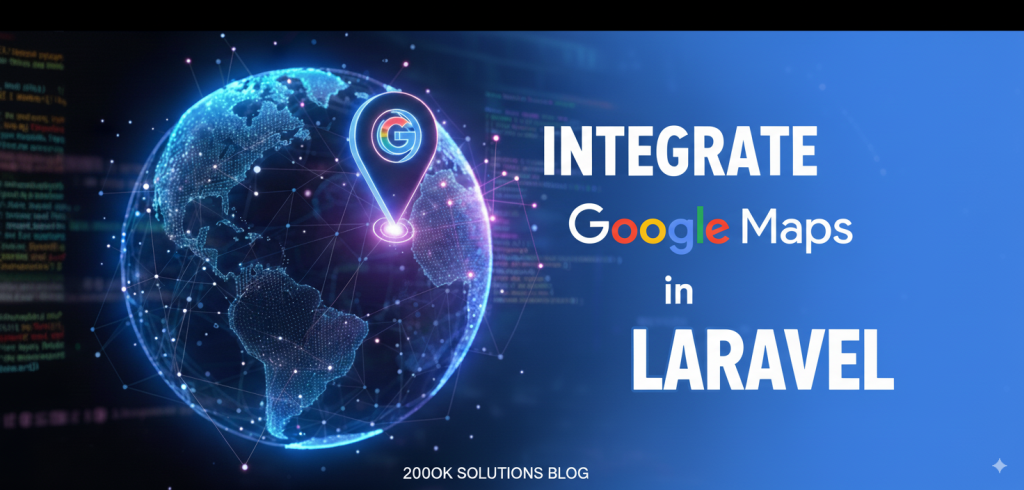
Google Maps is one of the most widely used mapping services, and integrating it into your Laravel application can enhance user experience significantly. Whether you want to display store locations, track assets, or build location-based services, Google Maps API makes it possible.
In this guide, we’ll walk through step-by-step instructions to integrate Google Maps into a Laravel project.
Step 1: Create a New Laravel Project
If you don’t already have a Laravel project, create one using Composer:
composer create-project laravel/laravel laravel-google-mapsStep 2: Create a View for Google Maps
Inside resources/views/, create a new Blade template called map.blade.php and add the following code:
<!DOCTYPE html>
<html>
<head>
<meta charset="utf-8">
<meta name="viewport" content="width=device-width, initial-scale=1">
<style>
.text-center { text-align: center; }
#map { width: 100%; height: 400px; }
</style>
</head>
<body>
<h1 class="text-center">Laravel Google Maps</h1>
<div id="map"></div>
<!-- Google Maps API -->
<script src="https://maps.googleapis.com/maps/api/js? key=YOUR_API_KEY&callback=initMap" async> </script>
<script>
let map, activeInfoWindow, markers = [];
// Initialize Google Map
function initMap() {
map = new google.maps.Map(document.getElementById("map"), {
center: { lat: 28.626137, lng: 79.821603 },
zoom: 15
});
map.addListener("click", function(event) {
console.log("Map clicked at:", event.latLng.lat(), event.latLng.lng());
});
initMarkers();
}
// Add Markers
function initMarkers() {
const initialMarkers = <?php echo json_encode($initialMarkers); ?>;
initialMarkers.forEach((markerData, index) => {
const marker = new google.maps.Marker({
position: markerData.position,
label: markerData.label,
draggable: markerData.draggable,
map
});
markers.push(marker);
const infowindow = new google.maps.InfoWindow({
content: `<b>${markerData.position.lat}, ${markerData.position.lng}</b>`,
});
marker.addListener("click", () => {
if(activeInfoWindow) activeInfoWindow.close();
infowindow.open({ anchor: marker, map });
activeInfoWindow = infowindow;
console.log("Marker clicked:", marker.position.toString());
});
marker.addListener("dragend", (event) => {
console.log("Marker dragged to:", event.latLng.lat(), event.latLng.lng());
});
});
}
</script>
</body>
</html>Note: Replace YOUR_API_KEY with your Google Maps API Key. (You can generate one from Google Cloud Console).
Step 3: Create a Controller
Generate a controller for handling the map logic:
php artisan make:controller MapController
Now, open app/Http/Controllers/MapController.php and add the following code:
<?php
namespace App\Http\Controllers;
use Illuminate\Http\Request;
class MapController extends Controller
{
public function index()
{
$initialMarkers = [
[
'position' => ['lat' => 28.625485, 'lng' => 79.821091],
'label' => ['color' => 'white', 'text' => 'P1'],
'draggable' => true
],
[
'position' => ['lat' => 28.625293, 'lng' => 79.817926],
'label' => ['color' => 'white', 'text' => 'P2'],
'draggable' => false
],
[
'position' => ['lat' => 28.625182, 'lng' => 79.81464],
'label' => ['color' => 'white', 'text' => 'P3'],
'draggable' => true
]
];
return view('map', compact('initialMarkers'));
} }Here, we are sending initial marker data (position, label, draggable property) to the view.
Step 4: Define Routes
Open routes/web.php and add:
use App\Http\Controllers\MapController;
use Illuminate\Support\Facades\Route;
Route::get('/', [MapController::class, 'index']);Step 5: Run Your Application
Start the Laravel development server:
php artisan serve
Now open your browser at:
http://127.0.0.1:8000You should see a Google Map with markers displayed.
In this blog, we integrated Google Maps into a Laravel application using the Google Maps JavaScript API.

